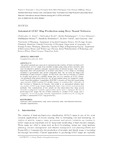| dc.contributor.author | Henry, Christopher J. | |
| dc.contributor.author | Storie, Christopher | |
| dc.contributor.author | Palaniappan, Muthu | |
| dc.contributor.author | Alhassan, Victor | |
| dc.contributor.author | Swamy, Mallikarjun | |
| dc.contributor.author | Aleshinloye, Damilola | |
| dc.contributor.author | Curtis, Andrew | |
| dc.contributor.author | Kima, Daeyoun | |
| dc.date.accessioned | 2019-08-08T16:50:50Z | |
| dc.date.available | 2019-08-08T16:50:50Z | |
| dc.date.issued | 2019-01-17 | |
| dc.identifier.citation | Henry, Christopher J., Christopher Storie, Muthu Palaniappan, Victor Alhassan, Mallikarjun Swamy, Damilola Aleshinloye, Andrew Curtis, and Daeyoun Kima. "Automated LULC Map Production using Deep Neural Networks." International Journal of Remote Sensing 40(11) (2019): 4416-4440. DOI: 10.1080/01431161.2018.1563840. | en_US |
| dc.identifier.issn | 0143-1161 | |
| dc.identifier.uri | http://hdl.handle.net/10680/1715 | |
| dc.description | Preprint version. | en_US |
| dc.description.abstract | This article presents an approach to automating the creation of land-use/land-cover classification (LULC) maps from satellite images using deep neural networks that were developed to perform semantic segmentation of natural images. This work is important since the production of accurate and timely LULC maps is becoming essential to government and private companies that rely on them for large-scale monitoring of land resource changes. In this work, deep neural networks are trained to classify each pixel of a satellite image into one of a number of LULC classes. The presented deep neural networks are all pre-trained using the ImageNet Large-Scale Visual Recognition Competition (ILSVRC) datasets and then fine-tuned using approximately 19,000 Landsat 5/7 satellite images of resolution 224×224 taken of the Province of Manitoba in Canada. The result is an automated solution that can produce LULC maps images significantly faster than current semi-automated methods. The contributions of this article are the observation that deep neural networks developed for semantic segmentation can be used to automate the task of producing LULC maps; the use of these networks to produce LULC maps; and a comparison of several popular semantic segmentation architectures for solving the problem of automated LULC map production. | en_US |
| dc.description.sponsorship | "This work was funded by a research contract with GeoManitoba, which is a department
in the Manitoba provincial government. This work was dependent on the generous support
and cooperation of GeoManitoba, including contributions by Greg Carlson, Jason
Hancheruk, and Gerry Lux. Similarly, the work would not have been possible without
help and support of the University of Winnipeg Research Office and Dr. Jino Distasio,
as well as the in-kind contribution to the GeoManitoba research contract by the
University of Winnipeg Research Office. Finally, Muthu Palaniappan and Mallikarjun
Swamy participated in this work through the Mitacs Globalink Internship program." | en_US |
| dc.description.uri | https://www.tandfonline.com/doi/abs/10.1080/01431161.2018.1563840 | en_US |
| dc.language.iso | en | en_US |
| dc.publisher | Taylor & Francis | en_US |
| dc.rights | info:eu-repo/semantics/openAccess | en_US |
| dc.subject | Land-use | en_US |
| dc.subject | Land-classification | en_US |
| dc.subject | Deep neural networks | en_US |
| dc.subject | Fully convolutional networks | en_US |
| dc.subject | Semantic segmentation | en_US |
| dc.title | Automated LULC Map Production using Deep Neural Networks | en_US |
| dc.type | Article | en_US |
| dc.description.version | Preprint | |
| dc.identifier.doi | 10.1080/01431161.2018.1563840 | en_US |

